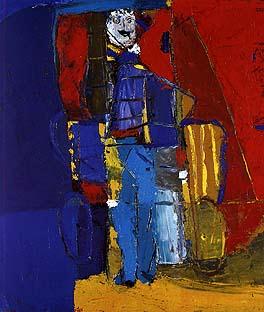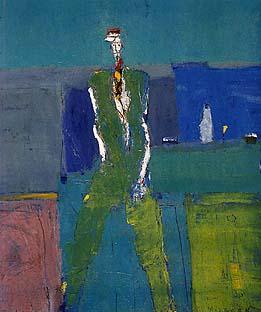Richard Bilan
"Figures"

"Figures"
Oil on materials
Born in Poland in 1946. Art studies in Jerusalem and Paris.
Graduated from the Academy of Art and Design "Betzalel"
in Jerusalem and from the national superior School of Decorative
Arts in Paris (Majored in visual communication and graphic arts).
Received the "Sharet Foundation Scholarship (1973) and the
French Government Scholarship for artistic creation (1974-1976).
Collaborated on the creation of industrial models for the glass
industry (1975).
Creation of animated commercials (1975).
Typographic development and illustration of art books (Les Impenitents).
His work of art can be found in several private and national
collections (National Library of Paris, The Tours Museum, Art
Museum of Israel, Jerusalem).
At present involved in the search for new patterns of ceatin
in the field of computerized infography.

"Figures"
Oil on materials
Tali Tamir - Critic and contemporary art curator, Israel
Richard Bilan paints and tells a story at the same time. His
biography,
published last year in Poland (it is written in polish, his mother
tongue),
sheds light on the conography he developed during the three decades
of his
work as an artist in the plastic arts. His is a world of human
characters and
types, mostly marginal characters, depicted with poetic sensitivity,
and
creating a rich web of short scenes and fragmented imagery, with
no clear
narrative discourse. It is a world of reminiscences of days begone,
in
Poland, reminding specific characters : father, mother, characters
of the close
vicinity, depicted with a virtuoso perception of their universally
human
features, through their gestures, facial expressions, even grimaces;
one may
even say: through word and sound. It is the encounter of child
s world, gone
and never to return, with all the nuances of French grace and
elegance.
Richard Bilan was born in 1946, to assimilated Jewish parents
who had
survived the Holocaust. He came to Israel in 1969 and graduated
from the
Graphic Arts Department of the Bezalel Academy of Arts, in Jerusalem.
As
an outstanding students, he won a grant which enabled him to
travel to
Paris, where he now lives and works. All those peregrinations
have
contributed to his personal style where contradicting influences
meet: on
the one hand, an East European tradition of popular narrative
and graphic
art; on the other, the interinalization of the rich French tradition
of painting,
which emphazises aesthetic and pictorial values based on colour
spots,
brush strokes and superposition of layers of colour, while paying
very close
attention to the chromatic and textual fabric.
The tension thus generated between the narrative, which tends
towards the
expression of human activity together with individual feelings,
and the
tendency of abstract painting toward universal generalisation
as well as
optimal equilibrium of the composition, endows Bilan's paintings
with a
kind of unrest which bursts through the chromatic harmony and
surface
textual fabric. There is also more then a touch of humour and
irony,
breaking thus the "sacrality" of the pictorial frame,
establishing instead, and
against the inner energy of the picture, a somewhat grotesque
character with
caricatural features, albeit personal.
Richard Bilan began his career as a painter through the graphic
dimension of
drawing; first as an engraver - on wood and copper. These two
techniques,
which by nature are close to the world of books and storytelling,
enabled
him to develop a personal and, indeed, magic iconography with
winged
angels as well as wetched drunkards. The storytelling dimension
of Bilan's
work glides thus, more and more, towards a world of imagination
and
legend : palaces, circuses and various types of clowns suddenly
spring up
among his characters.
His pencil sketches and colourful aquarels based on them, created
a flow of
theatrical scenes, harlequinesque situations and erotic characters
who are
depicted with a spontaneous and liberated stroke. The colourful
aquarel,
translucid, Iyric, magic, preserves the more childish and warm
features of
Bilan's works; whereas his oil paintings, which developed later
on,
integrate quite naturally the classic formula of western traditions
of
painting.
The same principles lie at the basis of Bilan's sculpture of
metal scrap
creating an indissoluble conjunction of the abstract and the
narrative, the
specific and the general; on the one hand, the serious, ponderous
tradition
of figurative sculpture; on the other, irony and humor expressing
themselves through the choice of the materials integrated into
the physical
composition of the characters. Both the metal scrap scultures
and those of
white linen soaked in plaster exploit the expressive power of
their material,
underlining the anticlassical features of the chracters : battered
household
utensils, teaspoons, pots and pans, old keys, broken cogwheels
or torn
fabrics soaked in white plaster, all build a frame of everyday
homelife
devoid of any sublime pathos. Those sculptures show always only
one
chracter, shaped with astonishing skill and retaining thus all
its humanity.
Recently, Bilan has engaged in new technique entwining sketch
and
sculpture by the means of relief paintings with characters made
of various
fabrics (especially all kinds of jeans fabrics) and emerging
out of rich
colour-and-sketch background.
The various attempts to find a thorough and unequivocal definition
of the
notion of "Jewish art", were never very successful.
They concentrated
around two opposite elements which critics and scholars considered
as part
of the Jewish weltanschaung: firstly, the human element, with
its
compelling respect for the sacred value of human life of all
men, be they
the most wretched and destitute; secondly and contrarily, the
abstract
element of denial of any physical representation, especially
that of the
image of man.
One may find such an expression of the human element in the works
of
Haim Soutine, the French Jewish painter. There, the human image
is
extended a position of central importance; not, of course, as
the
Renaissance humanistic entity endowed with rational and aesthetic
perfection; but instead, as an imperfect and faulty character,
able however
to preserve its human dignity in spite of its defects, through
the central
positioning within the pictorial frame. As for the abstract element,
it can be
found in monumental work of Mark Ruthko, the American painter
and, in a
even more dialectic way, in the contemporary works of the Israeli
painter,
Moshe Kupferman.
Richard Bilan's paintings and sculptures carry a moral commitment
towards
the marginal human character, deprived of its perfection and
lacking any
kind of pathos; yet still preserving its human and empathic qualities.
The
warmth on his drawing, his extreme sensitivity to colourfulness,
the
sensuality of his stroke of paint, his vituosic elaboration of
the human body
by use of old household utensils, all bear testimony of Bilan's
works as
retaining a humanistic vision which nourishes an artistic achievement
of
quality and human warmth.
Tali Tamir
Personal exhibitions
Group exhibitions
Prizes
[ Galerie Engel ]
|